10 Different Types of Slots on the Motherboard Explained.
Throughout the generation, various expansion motherboard slots have been used on the system board. Now, there are different types of slots on the motherboard introduced in order to expand and improve its functionality.
Since computers generally come with a basic set of input and output devices when assembling. Due to this reason, computers have expansion slots because many desktop PCs need to be upgraded or customized with extra hardware & features to carry out specific tasks that are not provided in the primary PC.
In the beginning, the usage of expansion slots was a lot because the motherboards were not as complete as they are now, and specific peripherals were needed.
In fact, newer motherboards have much options for expansion slots and features built right into the motherboard, eliminating the need for many cards additional expansion units.
And today you are in the right place because, in this article, you will discover the “All Types of Motherboard Slots” below:
What is the Purpose of Motherboard Slots?
The Motherboard is the largest circuit board often used in computers. It has a primary CPU (central processing unit) connected to an array of chips for peripherals like printers and speakers. These peripheral chips are separate from the CPU and communicate via expansion slots.
There are typically 24 expansion slots of 6 inches long on Motherboard, with each slot sporting eight pins that can be plugged in by inserting a flat cable into its appropriate site.
The purpose of these expansion slots on the Motherboard is to allow internal components to be connected to the main computer in order to increase performance capabilities or add new features without having unneeded parts within the casing of your computer case.
Different Types of Slots on Motherboard
You may notice, most motherboards have PCIe slots, but this is not the case of small PC cases. Also, if you come across an old motherboard, you will appreciate that it does not have this type of slot, but somewhat different ones. Let’s get to know the different types of slots on the motherboard.
1. PCI Slots
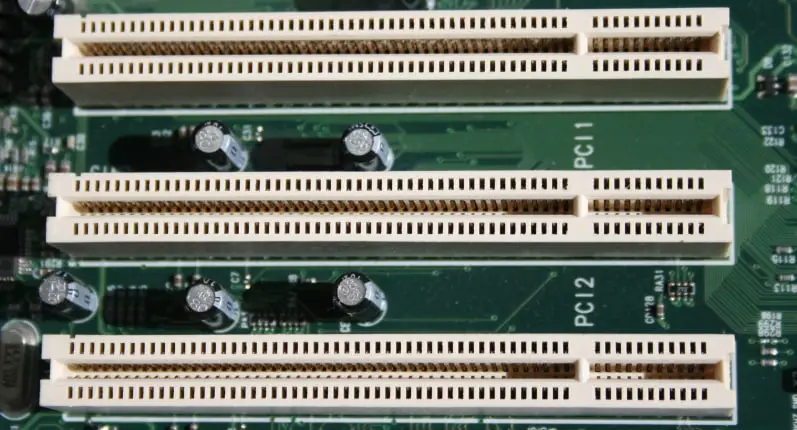
A PCI slot is an interface on the motherboard that allows you to put in a device that requires power, famous for coming with the first Intel Pentiums in 1993.
The PCI stands for ‘peripheral components interconnect’, a standard computer bus to connect peripheral devices directly to your motherboard. Its name comes from its physical location between two other elements and from the electrical signals it sends and receives.
The devices installed on such PCI slots are very diverse: various controllers, Wi-Fi adapters, TV tuners, satellite receivers, etc. The number of available slots on motherboards ranges from two to six.
2. PCIe Slots
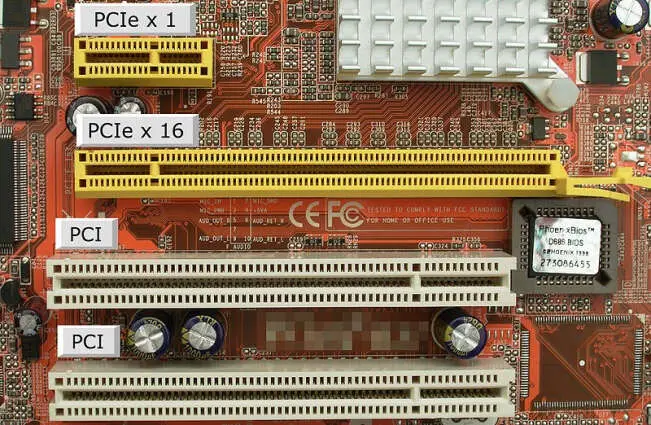
PCIe or PCI Express slots are the most common slots on the motherboard that optimize the communication with the microprocessor.
Well, it was a milestone in the history of computing, becoming a standard that has not yet been replaced but has been improved. It began to be used in 2005 developed by Intel, gradually replacing the rest of the expansion slot models.
When you need to mount a TV Tuner Card, Video Cards, or Storage Drives like NVMe based on a PCIe protocol, PCI Express Slots will be used for that purpose.
There might be several numbers of PCIe slots on the motherboard like PCIe x1, PCIe x4, PCIe x8, PCIe x16 port.
3. PCI-X Slots
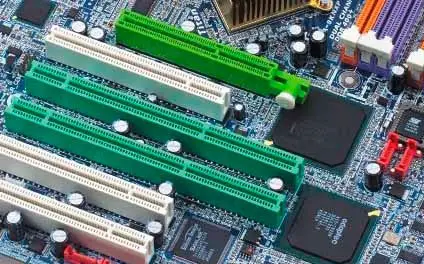
As a presence of the PCI slot, the PCI-X slot was also developed. You should not confuse these acronyms with PCI Express. The ‘X’ in this case refers to ‘expanded’.
One PCI-X slot on the motherboard is for the PCI Express (PCI-E)-based graphics card connected to the CPU via a dedicated 16x or 32x direct link to provide high bandwidth and low latency. The remaining slots are used for other functions as follows: –
- PCMCIA Card,
- Wireless adapter hardware,
- Bluetooth Card.
The motherboard may not have any slots left available if it has two PCI slots used by a RAID controller or another function.
Also, this type of slot isn’t widely used in the range of desktop motherboards. They are more oriented to server or workstation environments since they allowed higher bandwidths than conventional PCI.
4. AGP Slots

The acronym AGP stands for ‘Advanced/Accelerated Graphics Port’, and they are mainly designed to support video/graphic cards with high bandwidth requirements. The main advantage of these slots type is that they support a simple direct connection between the CPU and the motherboard without any PSU connectors or cables needed.
AGP slots are a type of motherboard used for personal computers which were popular in the early 2000s. Initially, AGP slots were designed as an upgrade to plain PCI slots. Now, this slot is the successor to the original PCI.
AGP was the mainstream until the successor standard PCI Express was put into practical use. It first appeared around 1997, and the version was released up to AGP 3.0, but due to the limit of transfer speed, it was almost replaced by the PCI Express standard around 2005.
The appearance of a new evolution known as PCI-Express provides more excellent performance in terms of frequency and bandwidth. Thus, the leading manufacturers of graphics cards, such as ATI and Nvidia, have presented fewer and fewer products for this port.
5. ISA Slots
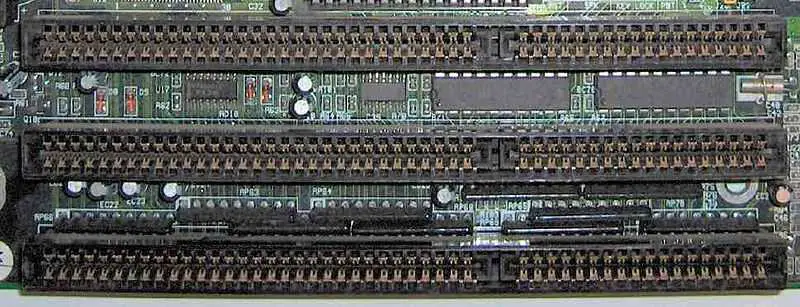
ISA expansion slots are the oldest types of slots on the motherboard. ISA stands for ‘Industry Standard Architecture’ because no other slots were invented at that time. The components designed to install on ISA slot were huge in size and among the first slots to be used in personal computers.
Network cards, video cards, and other extended hardware are installed with the help of ISA slots.
Today, Modern motherboards no longer have ISA slots. These slots were included until the first models of the Pentium III microprocessor, then it was replaced in 2000 by the PCI slot.
6. EISA Slots
The EISA ‘Extended Industry Standard Architecture’ slots were introduced to compete with Micro Chanel Architecture by IBM.
Are you looking for a new motherboard that can support more than 4 ESIA Slots? Luckily, most motherboards nowadays include five or more ESIA slots built-in.
The main thing to remember when it comes to ESIA Slot configurations is that they range from 1x to 16x. That’s because the number in front of the x denotes how many cards are in one slot.
7. VESA Slots
VESA stands for ‘Video-Electronics Standards Association’, it is a group of monitor and graphics card manufacturers that establish video bus and display standards. The aim of VESA slots is to optimize the video operations.
Although, VESA slots were only used in the PCs for a little amount of time. VESA Company introduced these slots but after some time, ISA Bus replaced VESA. In modern motherboards, Display port, HDMI, DVI -I, DVI-D, VGA are the ports used for display.
8. RAM Slots
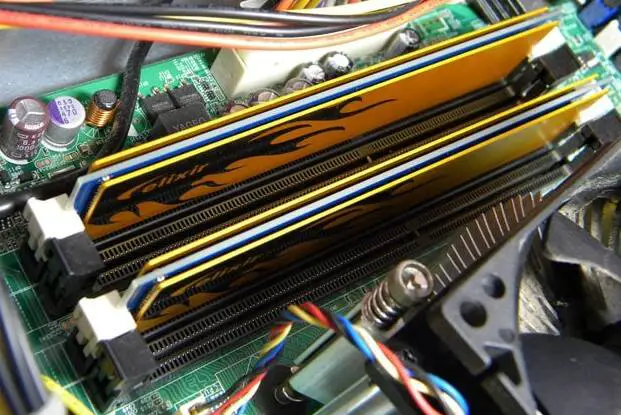
The RAM slot on the motherboard determines the RAM your computer can use. Some motherboards support the option to mix RAM, allowing you to use a combination of different RAM modules size, power and speed. Depending on the motherboard model, you’ll typically find 2 or 4 RAM slots (sometimes more on high-end motherboards), conveniently located at the upper-right corner of the motherboard.
Although the RAM slots are the last thing that comes to your mind when you’re purchasing your computer, it would be good to check that out too. Sometimes a motherboard can be a bit older, meaning that you can’t plug in the latest RAM modules to upgrade.
9. AMR Slots
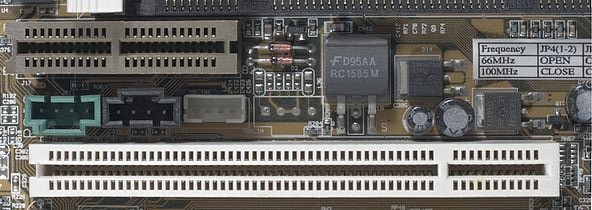
The AMR ‘Audio/Modem Rise’ slots are generally found on Pentium 3 and Pentium 4 computers on some of the motherboards. Intel designed these expansion slots to communicate with the motherboard by offering analog capability. These slots are used to install modems and sound cards.
This specification allows the motherboard to be manufactured at a lower cost and frees up industry-standard expansion slots in the system for additional compatible peripherals.
With the integration of modems and sound cards, more people using broadband, and better technologies like PCI Express, AMR never achieved mass adoption. Today AMR is no longer found or used with any modern motherboard.
10. CNR Slots
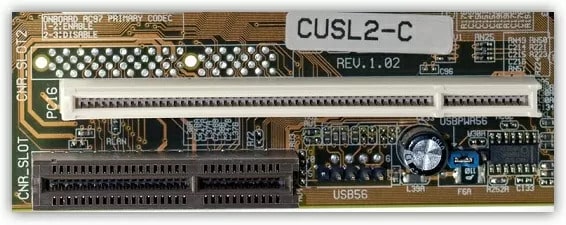
Communications and networking slot or CNR slot is only used by the customized systems for networking. It is a specification that supports audio, modem, USB, and LAN interfaces on core logic chipsets.
Today this slot is no longer found on motherboards and has been replaced by PCI and PCIe.
FAQs
Understanding these main types of slots on the motherboard can help you know some history and development of the various slots & the internal working of the PC in better ways.
Apart from these popular expansion slot types, here are some common questions that arise in the mind of users. Let’s get to know FAQs related to types of slots on motherboard.
How many expansion slots does my computer have?
Depending upon the computer manufacturer, the exact expansion slots keep varying. The total number of expansion slots is unique for every manufacturer. The best way to determine the total slots on the computer’s motherboard is to consult with the expert or reading the manual.
Which is the fastest expansion slot?
PCI Express slot is considered to be the most advanced and fastest slot on the motherboard. Most of the PCs from today come with PCI Express slots.
Does a laptop have an expansion slot?
It’s possible for a laptop to have an expansion slot, but it may not be possible for every model or design. Many laptops with expansion slots are designed with them in the back because they won’t impede the Wi-Fi signal or channel width or any other features on the device.
What is the most common expansion slot today?
PCI Express is the most common expansion slot today. It can be found on the motherboard of almost every computer today.
Which expansion slot is using the main memory?
PCI Express expansion slot replaced the older AGP, and it is used to accelerate the video tasks. So, the PCI Express expansion slot used the main memory.
Note: When installing an expansion card, before removing the case from the computer, be sure always to turn off the PC first and unplug the power cord from the back of the power source. Expansion ports are usually located near the RAM slots, but that’s not always the case.
Conclusion
If you want better quality hardware, then you will have to purchase an expansion card that plugs into your motherboard’s slot. One who wants the most customization will need a lot more than what the average user would need, so they should buy some upgrades before purchasing their PC from the store.
As with the slot on the motherboard, there is also a socket for the CPU. I have explained socket types too in the article.
If you liked the insights, you could share the article “Types of Motherboard Slots” on social networks too.
